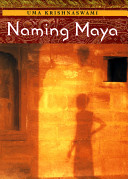
Naming Maya
Written by Uma Krishnaswami
Farrar Straus Giroux, 2004, 178 pp.
ISBN: 978-0374354855
“Maya’s gone away. I’m Preeta” (p.39).
Maya believes the trouble between her divorced parents began with her naming. Her father’s parents refused to accept the name her mother had chosen for her, which added to the chasm between her parents. Maya learned to use the names “like weapons” (p.39), which adds to her feeling of guilt after the divorce. Twelve-year-old Maya is spending part of her summer vacation in India despite having tried to avoid the trip. She and her mother have traveled from their New Jersey home to Chennai, India to sell the house of Maya’s grandfather after his death. They are joined at the house by her grandfather’s old housekeeper, Kamala Mami, who is suffering from the early stages of dementia. While Mami is struggling to remember, Maya is flooded with memories that she struggles to understand.
Naming Maya is set in the present in southern India. Maya brings a camera to record her trip. Her grandfather’s house is absent of the amenities to which she is accustomed, such as a shower with hot and cold running water. Maya bathes in a bathtub after mixing cold water from the faucet with boiling-hot water from a “little heater thing that hangs on the wall and needs to be turned on half an hour before bathing” (p.103). She has to share the bathroom with a gecko. There is no phone or computer access in the house. Maya and her mother have to go next door to make a call or to the Cyberconnexions store in town to surf the net. Chennai comes across as a mixture of the present and the past with its rickshaws and buses.
Although Maya attends Hindu culture camp in New Jersey, she is Americanized and notes that “every time she comes to India it’s like entering another world, a world that gets on fine without me in between my visits” (p. 17). Throughout her visit, she becomes more familiar with Tamil and Hindu languages, traditions and legends (including the true origin of her name). Maya is torn between the two cultures to which she belongs much the way she is torn between her two names and the parents who have chosen to end their marriage. The issues Maya deals with will be familiar to the novel’s targeted audience of readers who are ten-years and older. For upper elementary and middle school students, Naming Maya would make an excellent companion to Kashmira Sheth’s Blue Jasmine (2004), which depicts the main character leaving India to live in the United States. Both books address the mixture of cultures while intertwining issues that many adolescents encounter.
Uma Krishnaswami is a native of New Delhi, India and a graduate of the University of Delhi in India. She currently resides in the United States and is a writing teacher and an author of picture books and novels for children. She has written The Broken Tusk: Stories of the Hindu God Ganesha (1996), which was given the Scientific American Young Readers Award in 1997, and Monsoon (2003) among other titles. She has taught writing to both adults and children. She currently teaches at Vermont College of Fine Arts. Naming Maya was recognized in 2005 by the International Reading Association as a Notable Book for a Global Society. Krishnaswami is committed to creating books that are authentically accurate. More information can be found on her website: http://www.umakrishnaswami.com/ and at http://www.answers.com/topic/uma-krishnaswami.
Rhonda Hover, Oklahoma State University, Stillwater, OK
WOW Review, Volume IV, Issue 1 by Worlds of Words is licensed under a Creative Commons Attribution-NonCommercial-ShareAlike 4.0 International License. Based on work at https://wowlit.org/on-line-publications/review/iv-1/

Hello,
How I wish I had found this posting before I submitted my changes for the paperback version of Karma! As you can imagine it is not easy to write of Indian culture as a foreigner. All assurances to readers that I did enlist the help of three Indo-Canadian writers for assistance with the language (one writer of HIndu descent and two Sikh-Punjabi writers). Not only did they read for accuracy but also made many of the additions that you refer to as incorrect. Sigh. It is so difficult to get things right. Writing Karma was a very risky undertaking that I spent three years on. To explore both a culture and the dire political situation of 1984 as an outsider was fraught with peril but I was committed to telling this important story. My hope was to bring to light the relatively unknown massacre of the Sikhs to the general community as well as write about the difficulties of immigration, identity and adolescence. It was a work of passion that I am proud of. Many thanks for taking the time to read Karma and offer your thoughts. I learned much for your post. All my best, Cathy Ostlere
Hello Cathy,
Thank you for your gracious response! I thoroughly enjoyed reading the novel and was stunned at the meticulous descriptions of daily life in India, especially considering that your first visit to India was not exactly very pleasurable. India is complex and it is very challenging to view it as a single entity or a single theoretical construct. I admire and applaud your resolve to write a novel about my homeland despite the challenges of being an outsider. And I also applaud your thematic choice for the main plot – the riots following Mrs. Gandhi’s assassination are some of the least known and least discussed topics of Indian politics. I hope you will be writing another such powerful story set in India pretty soon! Warmest regards, Shri Ramakrishnan